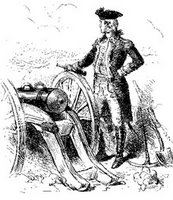When Was John Crane Wounded?
 A while back I quoted how Continental artillery officer John Crane was wounded in the foot. Boston 1775 reader Scott Crane got me interested in the exact date of that event, which doesn’t appear in my source, a memoir of Crane written by Dr. William Eustis and printed (reprinted?) in the Military Journal of Dr. James Thacher.
A while back I quoted how Continental artillery officer John Crane was wounded in the foot. Boston 1775 reader Scott Crane got me interested in the exact date of that event, which doesn’t appear in my source, a memoir of Crane written by Dr. William Eustis and printed (reprinted?) in the Military Journal of Dr. James Thacher.
Context says that Crane must have been wounded during the British military’s return to the U.S. of A. in the fall of 1776. The major landmarks of that campaign were the Battle of Brooklyn on 27-30 August, the landing at Kip’s Bay on 15 September, the Battle of Harlem Heights on 16 September, the Battle of White Plains on 28 October, and the taking of Fort Washington on 16 November. (Final score: Gen. Sir William Howe 5, Gen. George Washington 0.)
Using correspondence from 1776 that’s available online, I narrowed the window for when Maj. Crane was wounded. On 4 Sept 1776, Washington told Congress that the artillery officer was still quite active:
On Monday night a forty Gun Ship passed up the [Long Island] Sound between Governor’s and Long Island and Anchored in Turtle Bay. In her passage she received a discharge of Cannon from our Batteries, but without any damage and having a favourable Wind and Tide, soon got out of their reach.A transcribed digital copy of that letter appears in the Library of Congress’s collection of Washington’s papers. (Eustis’s account, written years after the war, differs on what guns Crane was using—a minor mistake.)
Yesterday morning I dispatched Major Crane of the Artillery with two twelve pounders and a Howitzer to annoy her, who hulling her several times forced her from that Station and to take shelter behind an Island where she still continues.
By 23 Sept, it appears, Crane had been wounded. On that date, his commander, Col. Henry Knox, wrote to his brother William:
Pay Mrs. Crane, wife to Major Crane, fifty dollars, and inform her that the Major is in a fair way to do well. He is in high esteem in the army, and the loss of his services much regretted by me.Knox obviously expected his brother and Mehitable Crane to have already heard about her husband’s wound. That implies Crane was hurt early in the month, soon after Washington’s letter. Dr. Eustis had more to say about the officer’s recovery. Eventually Knox became a general, and Crane a colonel. (And William Knox? Sooner or later I’ll discuss where he ended up.)
Online resources have also helped me clear up a mystery about the short biography of Crane’s colleague in carpentry and artillery, Ebenezer Stevens, that I quoted back here. I thought Stevens’s descendants had printed that booklet privately, but it’s an off-print from an 1877 volume of The Magazine of American History.

3 comments:
I'm researching my Crane family.I would love to know more about John Crane.And any Crane families in Mass.God Bless,Dennis
You may have sorted this all out by now, my friend, but if not, there is pension declaration that describes his wounding during an exchange with the 40 or 50 gun ship off Turtle Bay, prior to the Sept 15th attack when it was the only vessel there.
Rufus Avery – Groton CT
Capt. Abel Spicer, Col. Selden’s Regiment, CT Levies
“After a few days the Company was ordered to Turtle bay on the East river, then ordered into the entrenchments on Woods Point to cover the artillery while they were firing at Cornwallis who lay near Brooklyn with his 50 gun ship, the men exchanged about 500 shots, one man killed and the Maj. Of Artillery lost part of his foot by a shot near where said army was stationed. On the 15th of September the enemy landed on New York Island Gen’l Wadsworth’s Brigade in which he belonged were ordered to man the entrenchments on the East river at Turtle bay, soon after the enemy’s shipping passed along & anchored near Turtle bay and commenced landing troops to cut off the Brigade from the main body of the Army."
Thanks for sharing that firsthand source. I revisited the question of Crane’s wounding in this posting, using the dubious help of Gen. Heath’s memoirs.
Post a Comment